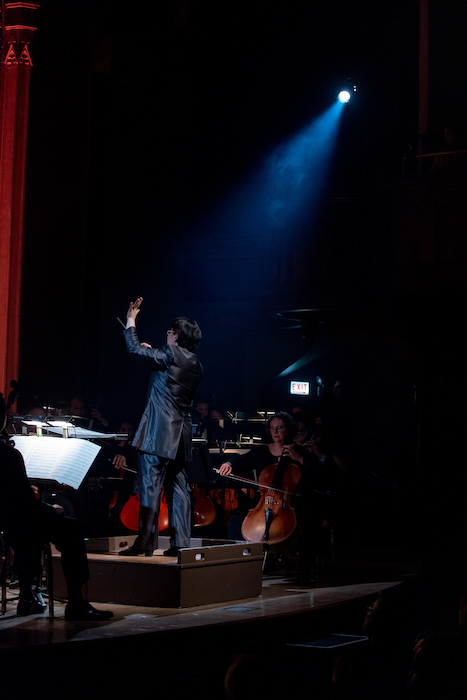Sinfonietta finds a new hall, revives a famous Górecki work

One must give credit to Jim Hirsch, CEO of the Chicago Sinfonietta, and his staff. When it became clear that the orchestra’s Monday night concert would be locked out of Symphony Center due to the ongoing strike by Chicago Symphony Orchestra musicians, Hirsch and colleagues—with a big assist from UC Presents’ Amy Iwano—sprang into action and managed to transfer the event to Mandel Hall, finding new seat assignments for their entire audience.
If the Sinfonietta can do that in less than a week, why can’t those in charge at Orchestra Hall find different venues for their non-CSO events instead of cancelling them? But I digress.
The principal work of the Sinfonietta program was Henryk Górecki’s Symphony No. 3, written in 1976. Subtitled “Symphony of Sorrowful Songs,” the Polish composer’s epic work became the unlikeliest of crossover hits in 1992 when the Nonesuch recording conducted by David Zinman, with soprano Dawn Upshaw and the London Sinfonietta, became the first classical CD to sell a million copies.
For all its chart-topping success, Górecki’s symphony didn’t have much of a shelf life in concert halls and after a flurry of performances vanished from view nearly as quickly as it had appeared. Monday night’s performance in Hyde Park may well have been the first performance of the work in Chicago in a quarter-century.
Yet Górecki’s symphony remains individual and distinctive: imbued with a strong Polish and Roman Catholic perspective, this epic symphony is universal in its directly emotional appeal, rising from dark lamentation and tragedy to a moving sense of solace and transcendence.
A 54-minute work of slow, melancholy music is an unusual work for an ensemble that seems most of the time to focus on short, undemanding showpieces. In her introduction, conductor Mei-Ann Chen said that the Zinman recording made a strong impact on her when she first came to the U.S. and it has always been her dream to conduct a live performance of this epic work.
For this concert the Sinfonietta’s string forces were filled out with members of the Chicago Youth Symphony Orchestras and students from the Merit School of Music. That likely contributed to some unfortunate wayward intonation from the double-basses in the hushed opening moments of the performance.
Chen clearly has great sympathy for this score and she skillfully directed the vast 26-minute arch of the first movement, a canon rising slowly, inexorably in warm consoling fifths through four octaves. If the strings were more sturdy than gleaming and polished, they responded to Chen’s patient direction throughout the long musical canvas.
Twyla Robinson, the soloist for the important vocal part, possesses the pure, plaintive timbre for the unnamed female protagonist. Yet in the central solo of the long opening movement—a 15th century Polish Stabat Mater prayer—Robinson’s climactic top notes sounded weak and under-projected, missing the crucial dramatic impact that should provide radiant light in the surrounding darkness and point the way forward for the rest of the journey. The loss of that sense of struggle and momentary gleaming triumph diluted the impact of the movement.
Robinson was better in the solos that come after, and most affecting in the finale, a Polish folksong with a text of a mother searching for her deceased son.
One was wary about the Sinfonietta’s “enhancements” to the Gorecki performance, including dramatic lighting and shifting background color projections; these proved largely subtle and unobtrusive until the final movement. More dubious was the bizarre conceit of stage “fog” piped in to create an atmospheric effect.
Most jarring of all was the didactic approach to the texts. Each movement was preceded by prerecorded readings—in English and by rather grating voices—of the Polish lyrics; this was a self-defeating distraction, wholly disrupting the contemplative mood established by the musical performance.
As both the admirable playing and the rapt and attentive listening made clear, you don’t need this kind of theatrical shtick if you have a solid performance of good music. The Sinfonietta audience is much more sophisticated than those in charge give them credit for.
The first half of the program offered three short works—two setting the introspective mood for the Górecki, the other not so much.
As introduced by the composer, Ilya Levinson’s Sevdah Medley works four Bosnian folk songs into the kind of flavorful ethnic musical stew often programmed by the Sinfonietta. Apart from Eastern European geography, the lightweight showpiece had little to do in style or substance with the evening’s main work. Chen led a brash and lively account underlining the klezmer-like clarinet lines.
The evening opened with an orchestral arrangement of Debussy’s Clair de lune. With Chen tamping down the syrup, it served as an admirable calling card, showing that the mid-size Mandel Hall can accommodate a full orchestra surprisingly well—offering a warm, rounded sound without overwhelming fortissimos.
Violinist Paul Zafer was the soloist in Ralph Vaughan Williams’ A Lark Ascending. Though not always immaculate in intonation, the Sinfonietta’s concertmaster offered a sensitive and atmospheric rendering, at his best in the gentle avian solos that frame the work.
The Chicago Sinfonietta concludes its season May 11 and 13 with guest violinist Regina Carter. The program includes Elgar’s Enigma Variations, Jessie Montgomery’s Strum and David Schiff’s 4 Sisters. chicagosinfonietta.org
Posted in Performances






Posted Mar 26, 2019 at 9:43 pm by Joan Staples
We are long time subscribers. The Sinfonietta has a diverse repertoire purposely, highlighting new works as well as those tried and true.
The reviewer seemed somewhat condescending, I thought. Zafer was an excellent soloist, but did you hear the assistant concertmaster’s brief appearance? The reviewer also did not mention that Gorecki’s work was very minimalist. We thought the soloist was enjoyable. We go to many concerts, so are not new to the finest musicians. The Sinfonietta is one of our favorites.